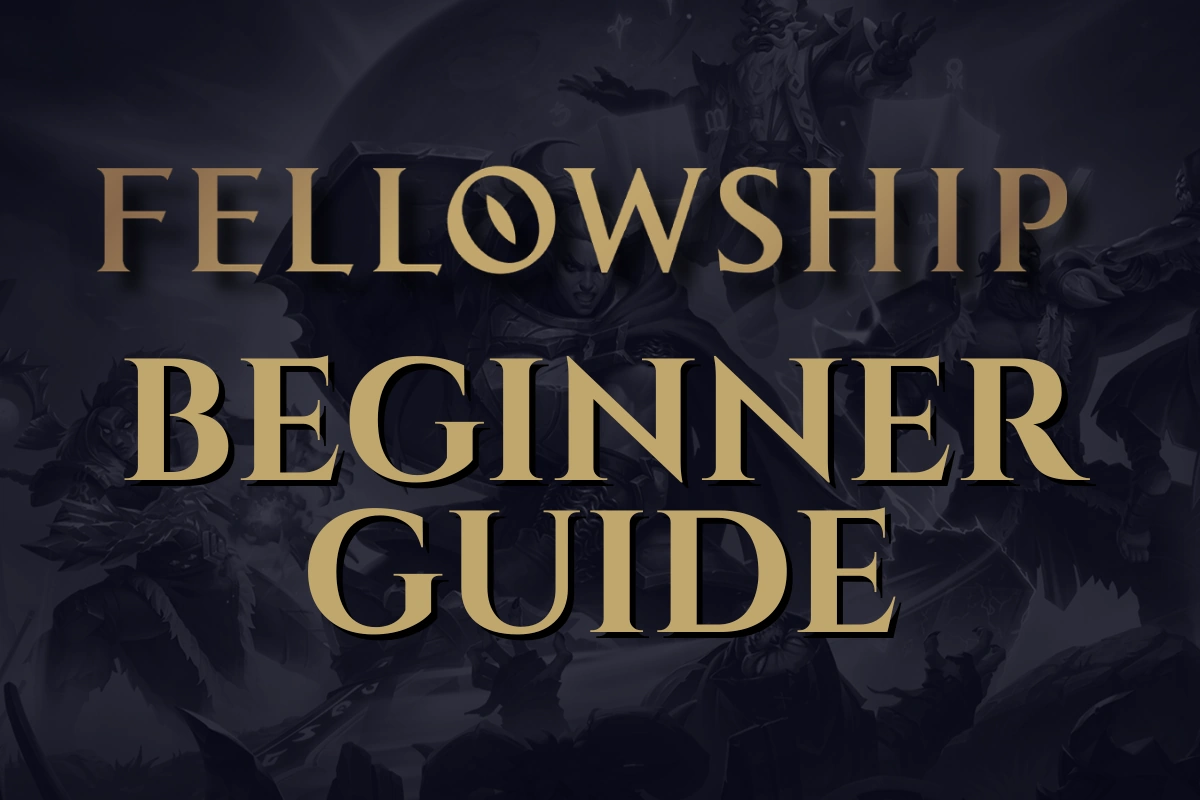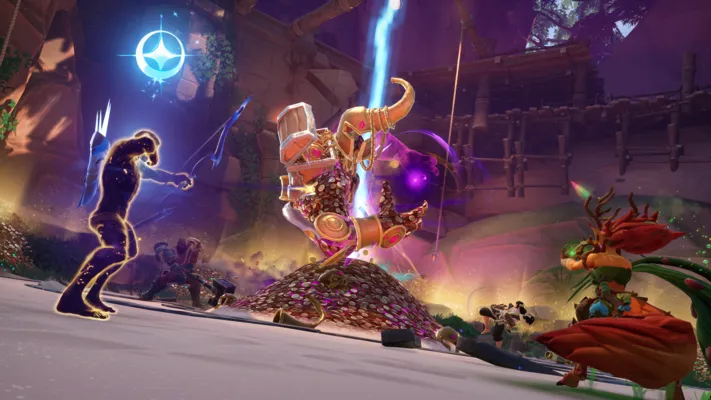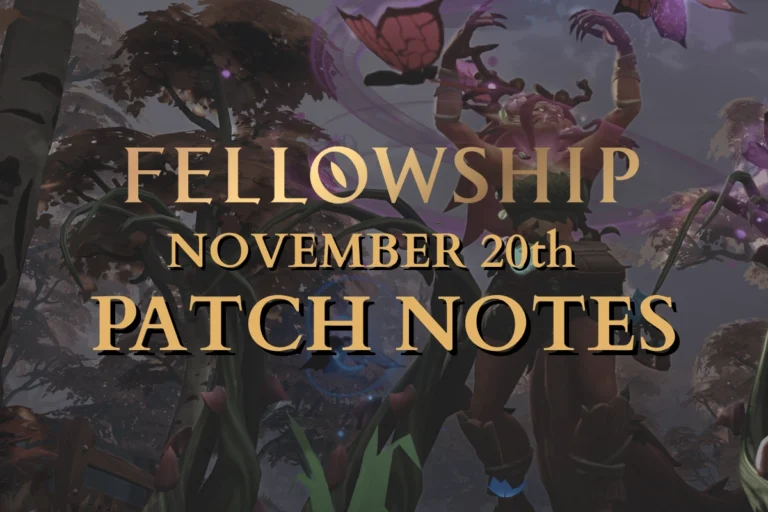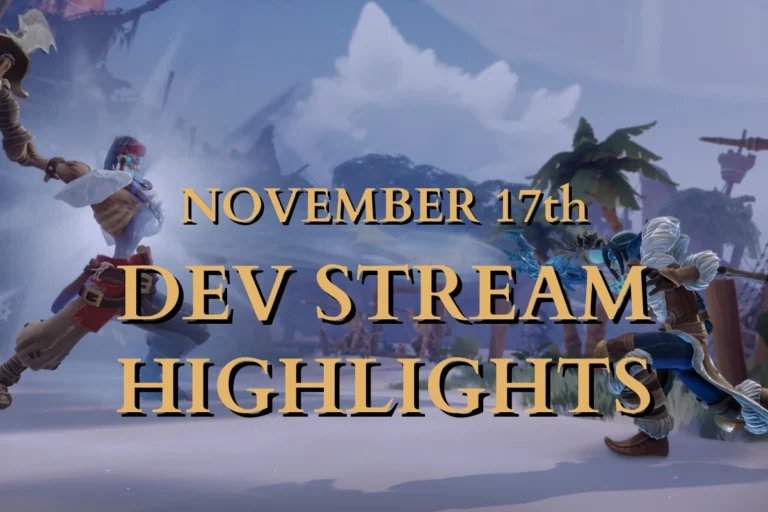Fellowship is a multiplayer online dungeon adventure (MODA) that focuses on cooperative, endgame-style dungeon crawling. Rather than a long single-player campaign or open world, the game is built around repeatedly tackling scalable dungeons with a team, gathering loot, facing bosses, and improving gear.
It combines design elements of MMOs and MOBA / hero-based games, with a fixed hero roster rather than full character creation.
This Fellowship Beginner Guide will introduce you to all the unique mechanics and core systems that Fellowship has.
Table of Contents
- What is the Premise?
- Dungeons, Leagues and Curses
- Heroes, Roles and Abilities
- Gearing & Hero Progression
- Stats, Substats and Diminishing Returns
- Currencies and Vendors
- Combat Controls and Quality of Life
- Interrupting Casts and Crowd Control
- Beginner Tips
What is the Premise?
Fellowship, players select from a roster of pre-designed heroes (each belonging to one of three roles of the holy trinity: Tank, Healer, and DPS) and enter dungeons in teams of four. The world and lore are built around a fantasy setting where cooperation and execution matter more than isolated power.
As you progress, dungeons scale in difficulty, introduce extra modifiers, and new enemy abilities. The aim is not just to beat dungeons, but to optimize runs, improve gear, and climb leaderboards.
Dungeons, Leagues and Curses
Dungeon Basics
Dungeons are the main content within Fellowship. In dungeons, you will have to fight through enemy mobs with your party to get to a kill score of 100% and then defeat the boss at the end to complete it and get rewards at the end.
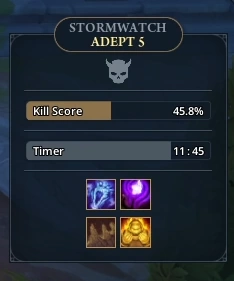
Each dungeon has a time limit allocated and the objective is to beat it before the time runs out. This is called timing a dungeon run. Even if you don’t time a dungeon, you still get rewards at the end. If you run too far into overtime, your rewards are reduced but it’s still worth completing.
Dungeons are timed and contain more enemies than needed for a 100% kill score and multiple branching pathways. Planning efficient routes through them is key to success.
Death in Fellowship has no penalty other than time loss. Within dungeons are various Campfires which act as respawn points, and can help mitigate time lost when dying.
Dungeon Types and Difficulties
The game features one-boss dungeons roughly 12-minutes long sometimes referred to as Adventures. These dungeons increase in difficulty from +1 to +6 within each league, increasing the power of the enemies and adding new enemy abilities and dungeon curses, but granting stronger loot.
As you progress through the game, you’ll be placed into 3-boss Capstone Dungeons. These dungeons are longer and more difficult, taking about 28-32 minutes to complete. They’re unlocked at +7 of each league. These have unique bosses, mechanics, and loot and offer a challenge that when beaten unlocks rewards and access to the next Challenger League.
Capstone Dungeons‘ rewards are considered one league higher when timed, so a Contender +7 dungeon will drop Adept gear.
Fellowship Gamemodes
There are three main gameplay modes for Fellowship, Quickplay, Challenger Leagues, and Eternal.
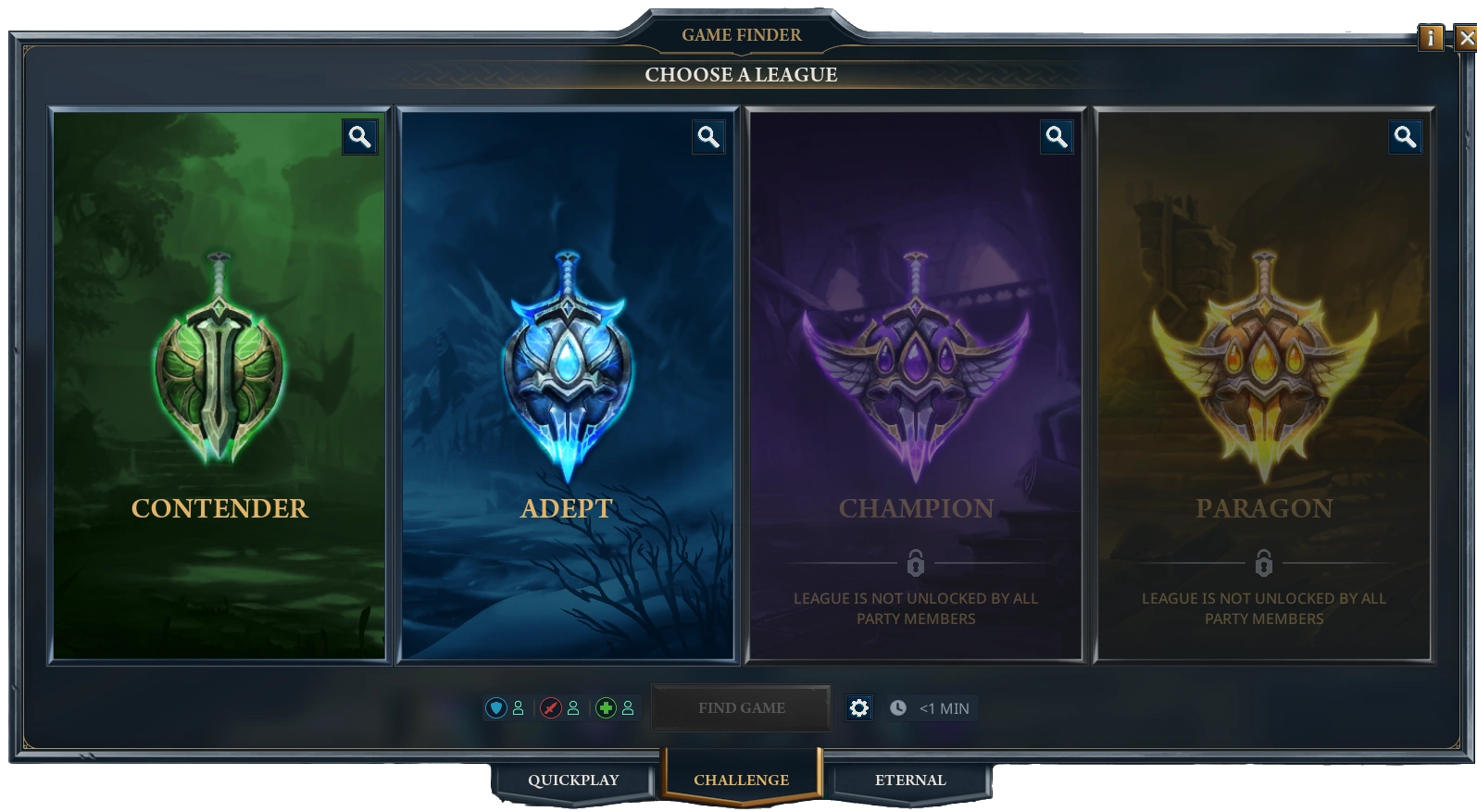
Quickplay
Quickplay is a low difficulty match-making queue that normalizes equipment levels, has no timer, and lets you play with anyone at any point in the game. This is great for casual runs, learning new heroes and roles, or playing with friends at different points of progression.
This mode puts you into any random one-boss dungeon, and with an experienced team can be speedran in as little as 6 to 7 minutes. Each quickplay rewards 4 Quartermaster Tokens to buy basic gear with and 2 Cache Keys, used to buy material chests used for gear upgrading and modification. Both of these are account wide.
Challenger Mode
Challenger is the game’s prominent system. Here you’ll start getting gear drops and progress your hero into higher level difficulties.
Instead of just cranking up the numbers, higher leagues unlock new abilities for mobs and bosses, and new dungeon curses that change the way you’ll play each of the dungeons. The difficulty sharply increases later in the game, and while it remains possible for experienced players and teams, more casual players can push their item level and gear progression safely to help overcome challenges.
Each Challenger League has difficulties +1 to +7, with +7 being reserved for the capstone dungeon.
The Leagues in Challenger mode are as follows:
- Contender
- Adept
- Champion
- Paragon
Eternal Mode
After defeating the capstone dungeon in Paragon, you unlock Eternal mode. There is no concrete information about the mode yet, but we do know that it will feature capped rewards but uncapped difficulty, intended for limitless leaderboard climbing and achievement.
Dungeon Ascensions
At Contender +4, the Asha’s Dilemma Ascension is enabled. This is when dungeons start becoming timed, and must be completed within time to get full rewards and rating.
At Contender +7, the Vayr’s Legacy Ascension is enabled. This grants enemies and bosses new abilities not seen before this difficulty.
Dungeon Curses
At Adept and higher difficulty, dungeons will have curses applied. Curses are a special modifier that often changes how you’ll need to treat the dungeon. For example, Empowered Minions might make you change course to avoid a strong mob. Curses also have a bonus that the players can interact with. In the case of Empowered Minion, when you defeat one you get a haste and movement speed buff.
These are static per difficulty and not random. For example, if an Adept +5 Stormwatch has Empowered Minions, it will have this curse every time. This lets you get used to any route changes or tricks per dungeon.
Dungeon Rating
As you complete dungeons, your dungeon rating will increase for that hero. This unlocks rewards and determines your rank on the in-game leaderboard.
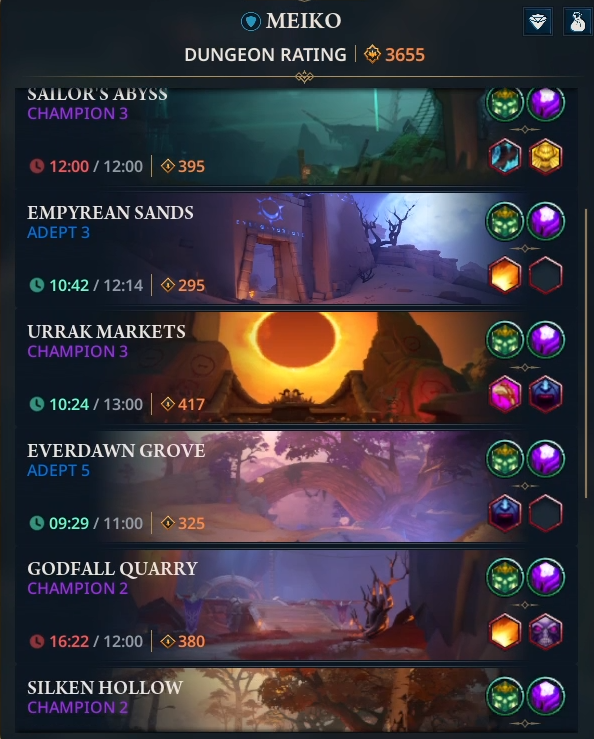
Dungeon Rating is calculated based on the highest difficulty cleared of each unique dungeon. Finishing faster gives a slight boost to rating rewarded.
Heroes, Roles and Abilities
Hero Roles and Archetypes
Fellowship uses the classic trinity system: Tanks, Healers, and DPS. You’ll form a party of four (one tank, one healer, two DPS) in dungeon runs.
Each hero has unique mechanics (builders/spenders, pet mechanics, combo systems, etc.) that distinguish them.
The roster during Early Access includes:
- Helena (Tank): Generates Toughness through basic attacks and cooldowns, keeping damage received down.
- Meiko (Tank): More combo / chain based; uses combos, self-buffs, self-healing and finishers.
- Sylvie (Healer): Pet and nature themed healer support. Commands Flutterflies for Healing-over-Time effects and places damaging thorn pets.
- Vigour (Healer): Holy builder / spender healer with strong burst and damaging heals. Generates and uses Radiant Runes for healing or damage.
- Ardeos (DPS): A fire based ranged caster. Many skills apply burn / DoT effects and uses Burning Embers to detonate those DoTs for burst damage.
- Rime (DPS): Frost-based ice mage with builder / spender mechanics. Builds Winter Orbs which can be used for damage during burst windows.
- Mara (DPS): Stealth and rogue style melee DPS. Uses poisons and generates combo points used for burst attacks.
- Tariq (DPS): A beserker who wields thunder and a large hammer. Build/spends Fury and weaves lightning into his attacks.
- Elarion (DPS): A marksman-style ranged DPS. Uses a bow and Focus + cooldown management to deal damage while also having high mobility.
For further details on each Hero, check out our Hero guides:
Tanks
Healers
DPS
You can swap heroes between runs. Some progression such as currency and tokens are shared so you can experiment without penalty or having to re-roll entire new characters.
Talents and Respeccing
Each hero has a talent tree to choose from passive bonuses and upgrades to your abilities. Throughout the game you unlock a total of 13 points depending on which tier of difficulty you’ve reached. Points can be spent on any talent in any row, and you can respec any time for free between runs in the stronghold to experiment.
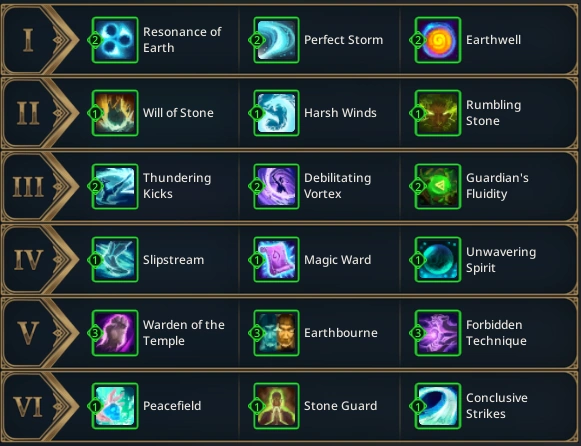
Starmap Rewards
The Starmap is a progression track that unlocks your talent points and abilities for each Hero. There are three tracks with different types of rewards:
- Left Track: Unlocked via dungeon completions of any difficulty. Rewards talent points, talent rows and unlocks abilities.
- Center Track: Unlocked via Rating and progression in Challenger League. Rewards extra talent points, gear, currency, materials, and cosmetics.
- Right Track: Account wide cosmetic mount rewards. Unlocked permanently when completing a Challenger League.
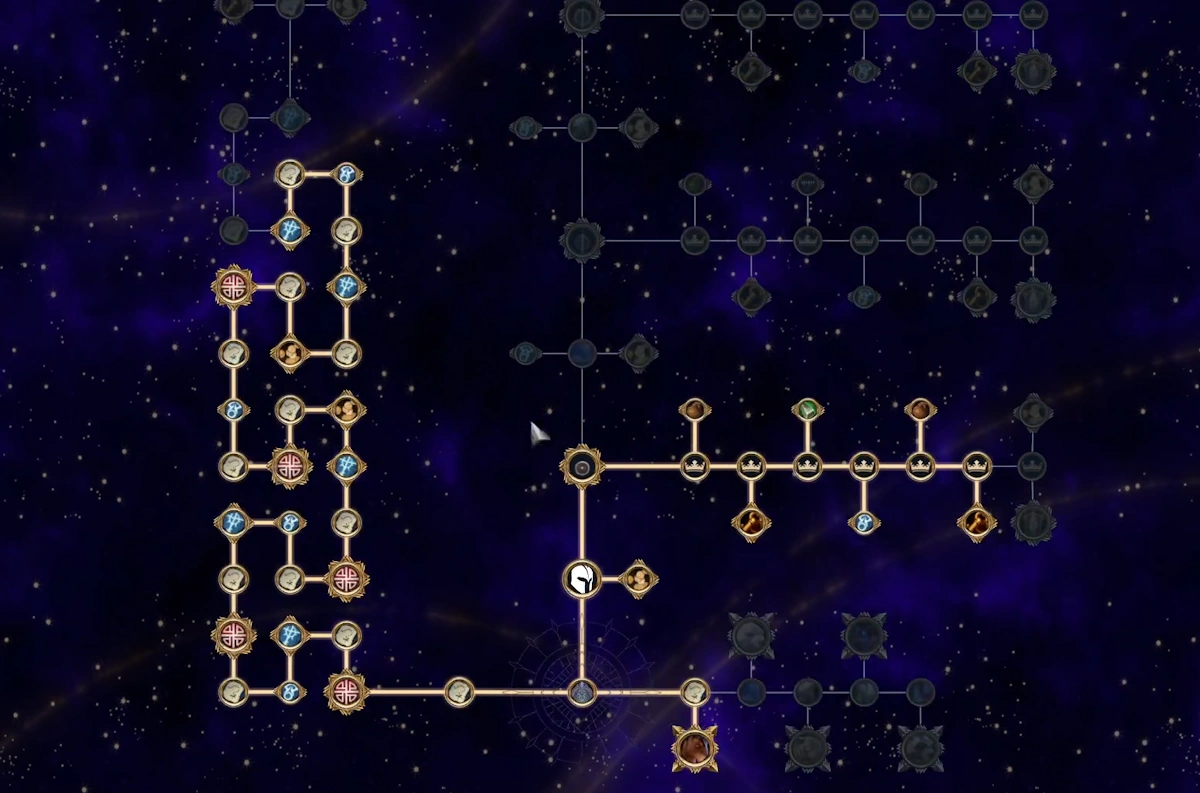
A common shortcut for progression used by players is to rush through 8 Quickplays. This gives you enough Quartermaster Tokens to buy a full set of gear to fill every slot from the equipment vendor, and unlock your left-side track to get all of your abilities.
From there you can do Contender +5 and +6 to get some extra rewards off the center track, or it’s possible for experienced players to finish Contender +7 right away.
Gearing & Hero Progression
In Fellowship, hero power isn’t about leveling and more about gear, item level, gems, and progressing difficulty tiers.
Gearing your Heroes
Gearing works similar to MMOs and ARPGs. Upon completing a dungeon you’ll get random pieces of gear based on the type, difficulty and league of the dungeon you’re running.
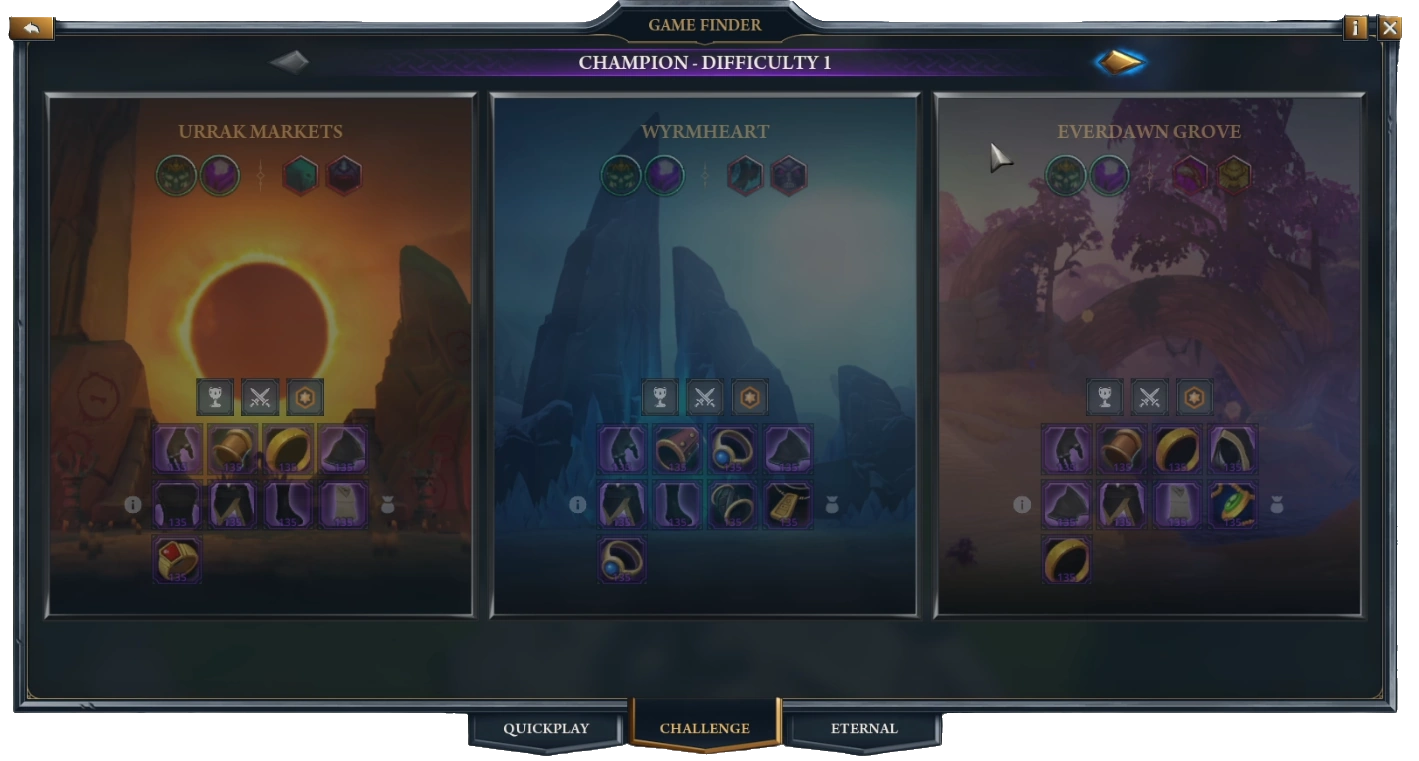
Item Details
- Item Level: Every two levels of difficulty increases the base item level of the drop. Item level can be increased through gold and materials earned by dungeons and salvaging gear up to a cap based on the Item Rarity. Item level decreases if you go too far into over-time during a dungeon, down to the lowest of the respective rarity
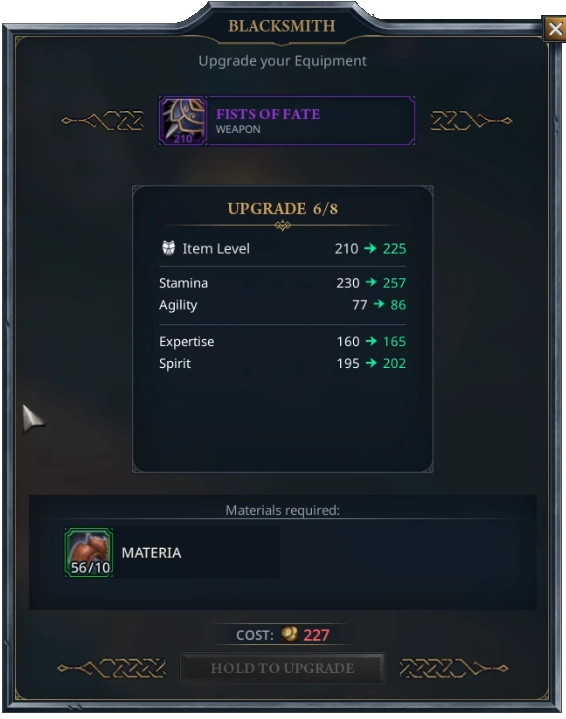
- Item Rarity: Every time you reach a new rank of difficulty, dungeons drop an increased rarity.
- Common: Bought from the Quartermaster vendor with Quartermaster Tokens.
- Uncommon: Dropped from Contender difficulty dungeons. Item level caps at 120.
- Rare: Dropped from Contender’s Capstone Dungeon and Adept difficulty dungeons. Item level caps at 180.
- Epic: Dropped from Adept’s Capstone dungeon and Champion difficulty dungeons. Item level caps at 240.
- Champion: Dropped from Champion’s Capstone and Paragon difficulty dungeons. Item level caps at 300.
- Gear Sets: Each dungeon has their own specific gear set for each Hero that gives a strong flat bonus to stats or have bonus effects. Capstone dungeons often have a unique and powerful set bonus compared to 1-boss dungeons.
Relic Items
Heroes can equip two relic items and come with an extra utility abilities that can be dropped in any dungeon Contender difficulty and higher. These items can give healing, party-wide buffs such as damage resistance or movement speed, or route-based items such as teleport portals and stealth to skip trash.
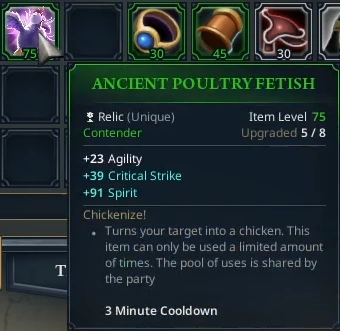
For a more detailed look at relics including a which relics are best to use where, take a look at our Fellowship Relic Guide.
Sockets and Gems
At Adept difficulty and higher, gems can drop and items can randomly drop with gem sockets. Gems have gem power, which unlocks passive bonuses for your character that progressively get more powerful as you reach further in each type.
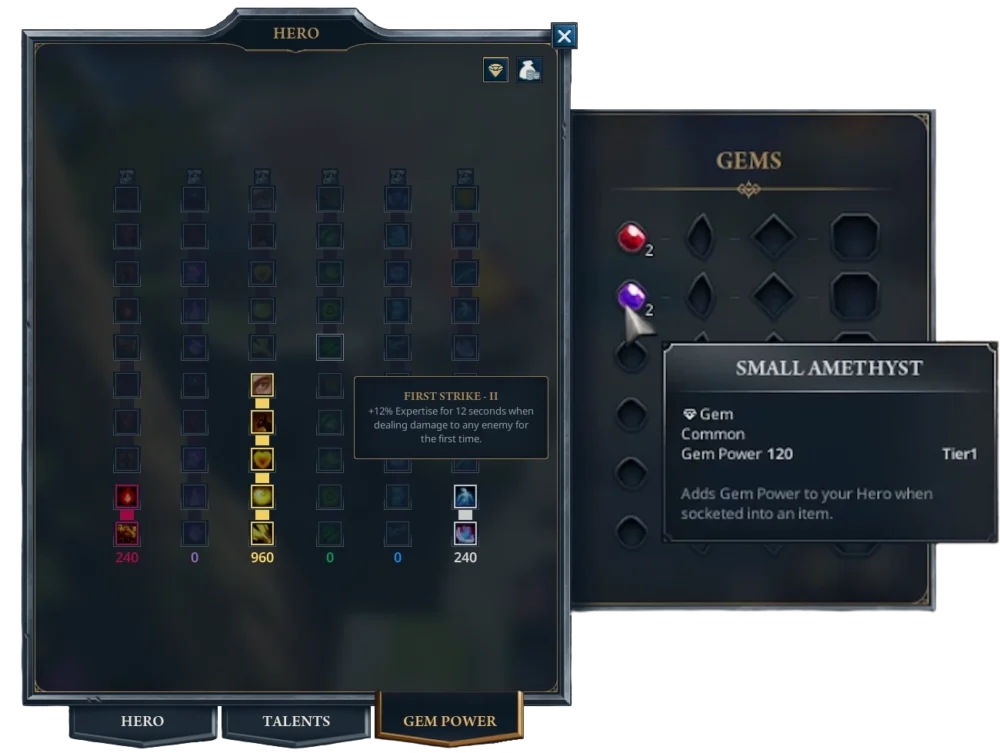
These bonuses can range from boosts to stats to conditional effects. These are also flat bonuses that are not affected by diminishing returns.
For a more detailed look at gems view our Fellowship Gems Guide.
Weapon Abilities and Weapon Trees
Each type of hero (Tank, Healer, Melee DPS, Ranged DPS) has a pool of weapon items that can drop in any dungeon Adept difficulty and higher. These items come with a unique weapon ability, an additional ability to be used in combat that can deal high damage or grant powerful effects and buffs.
At Epic rarity and higher, weapons come with a randomly-generated weapon tree that grants even further passive bonuses and upgrades.
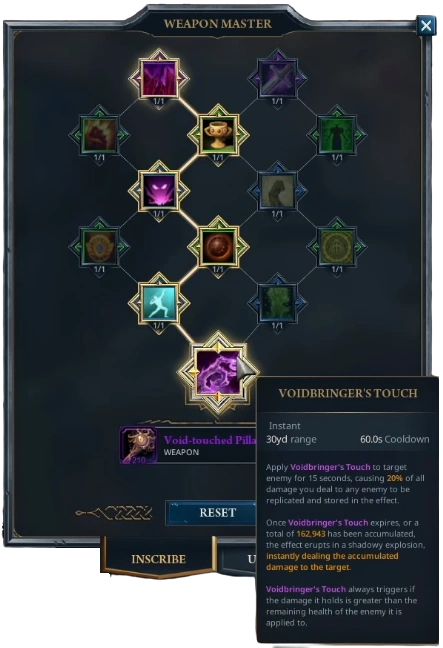
Legendary Items
Each hero has a pool of Legendary items that can drop in any dungeon Champion difficulty and higher. These items come with an affix that can significantly change the way the hero’s abilities work, and sometimes are even worth building entire talent trees around. These items always drop at level 300 in Champion and 330 in Paragon.
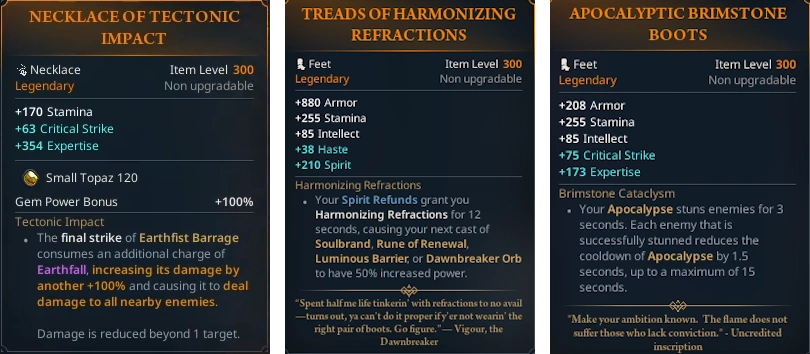
You can only wear one legendary at a time.
Stats, Substats, and Diminishing Returns
Heroes have two primary attributes and four secondary attributes that can be upgraded through gear, set bonuses, gem bonuses, passives, etc.
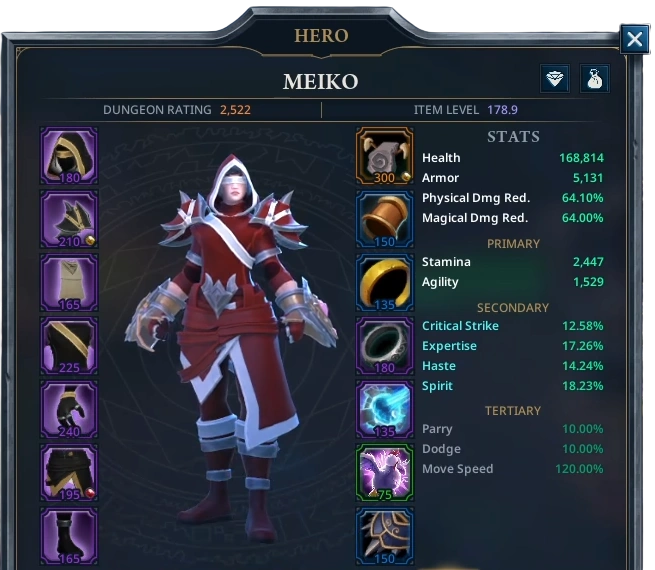
Increasing item level on gear is generally far more efficient than focusing on specific stats.
Primary Attributes include:
- Stamina: Each point of Stamina is additional HP depending on the Hero.
- Strength / Agility / Intellect: Damage scales off the hero’s respective primary stat.
Secondary Attributes are shown as percentiles. You get 0.017 stat percent per rating point. Secondary attributes include:
- Critical Strike – Chance for damage and healing effects to crit, doubling their effect.
- Expertise – Increases all damage, healing and absorption effects triggered by the Hero.
- Haste – Decreases cooldowns, Increases attack speed, casting speed and the tick rate of damage and healing effects.
- Spirit – Increases the rate you charge your spirit ability. Every % of Spirit gives a chance for a bonus effect, different for every Hero.
The formula for Spirit effects is Spirit% / (1 + Spirit%). 20% Spirit = 0.2/1.2 = 16.667% chance.
Diminishing Returns
Secondary attributes are affected by Diminishing Returns (DR). Beyond 10%, each rating point has less weight towards the stat percent.
- From 0-10% you get full value.
- From 10-15% you get 0.95 value.
- From 15-20% you get 0.9 value.
- From 20-25% you get 0.85 value.
- Beyond 25% you get 0.8 value
Due to these diminishing returns, even though heroes have their own stat priorities, it’s good to spread your secondary stats out.
Boosts to secondary attributes such as from set bonuses or talent passives are added on top of rating after diminishing returns.
Fellowship Currencies and Vendors
In the Stronghold, you’ll be able to trade use various currencies, trade with vendors and use workbenches to improve and progress your character. Currencies are account bound and materials are hero bound.
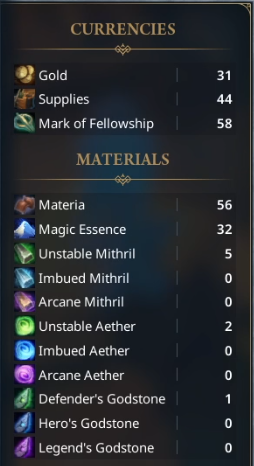
Scrapper

Gear can be scrapped for Gold and Material / Essence at higher levels. Scrapping upgraded gear returns half of the gold and materials spent to upgrade it.
Bjorn the Blacksmith

The Blacksmith will upgrade your gear for a gold cost to a cap based on their rarity. Later item levels require extra Common Materia and Enchanted Materia as well, found as rewards from dungeons and from scrapping other high level gear.
Shrine of Infusion
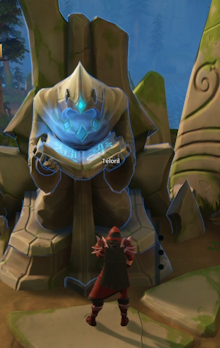
Here you can choose your weapon talents for any Epic or higher weapon. Like talents, respeccing is free.
Master Craftsman Braggi

At the Craftsman you’ll be able to reroll items into other items using mithril and gold. The rarity of the ingot determines the type of reroll or upgrade you can do.
- Unstable Mithril: Transform an item into a random item of another slot
- Imbued Mithril: Transform an item and choose from one of three items of random slots
- Arcane Mithril: Transform an item and choose from one of three items of the same slot
Using Aether you can combine gems of the same color into larger ones:
- Unstable Aether: Combine 3x Small Gems into a Large Gem of the same color.
- Imbued Aether: Combine 3x Large Gems into a Splendid Gem of the same color.
- Arcane Aether: Combine 3x Splendid Gems into a large Flawless Gem of the same color.
Or reroll gems into random colors:
- Unstable Aether: Transform a gem into a different random color.
- Imbued Aether: Transform a gem into a different random color, between a choice of 3 colors.
- Arcane Aether: Transform a gem into any color of your choice.
Finally, youcan also use Godstones to reroll various properties of a weapon, changing what is available on its Weapon Tree.
- Defender’s Godstone: Reroll all defensive traits of an item.
- Hero’s Godstone: Reroll all heroic traits of an item.
- Legend’s Godstone: Reroll all major traits of an item.
Cassian the Jeweler
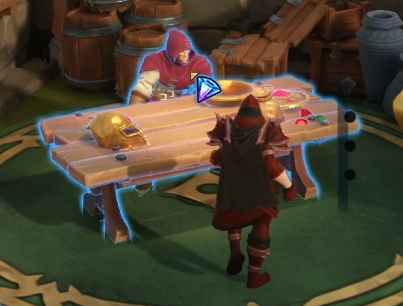
At the Jeweler you’ll be able to extract gems from items for free.
Quartermaster Novak
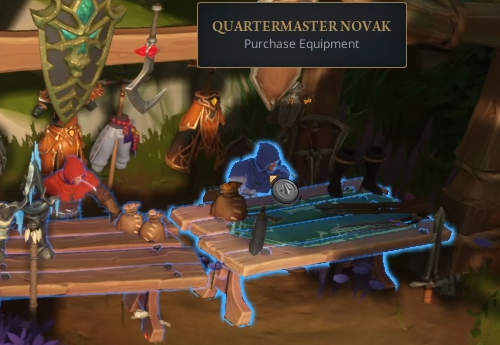
You can get gear from the Quartermaster using Supplies earned through Quickplay and sometimes as drops from dungeons.
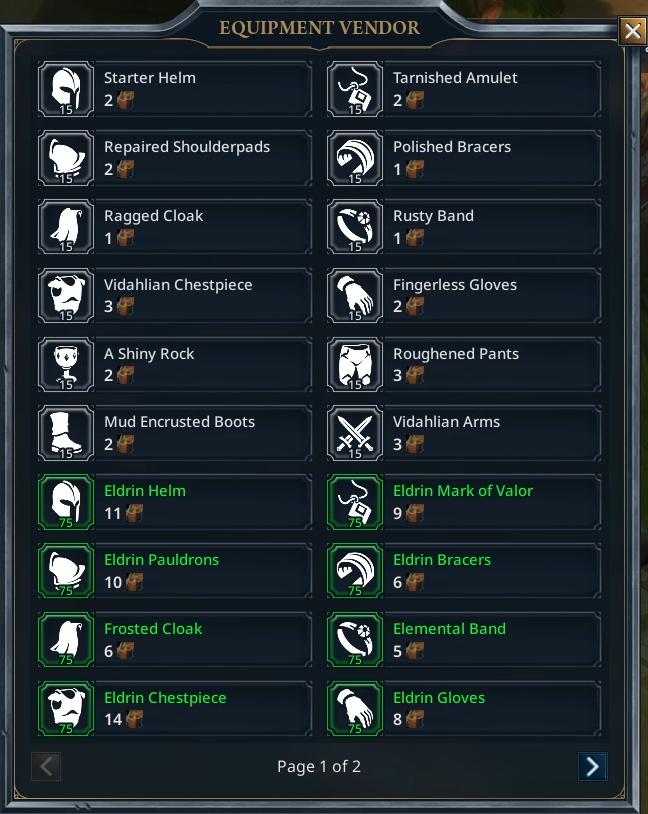
These basic items are best used to fill empty slots. The level limit of the gear you can buy increases based on your account’s progression. League 1 gear for example is purchased after completing Contender +7 on your account. Note that League 1 gear when purchased is still Common. Common items cannot be upgraded.
Outfitter Brenhem
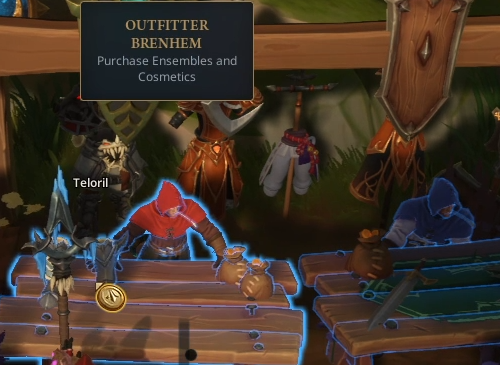
The Outfitter is a cosmetics vendor that sells outfits for heroes at some pretty steep prices (Up to 15,000 gold).
Storekeeper Keiren
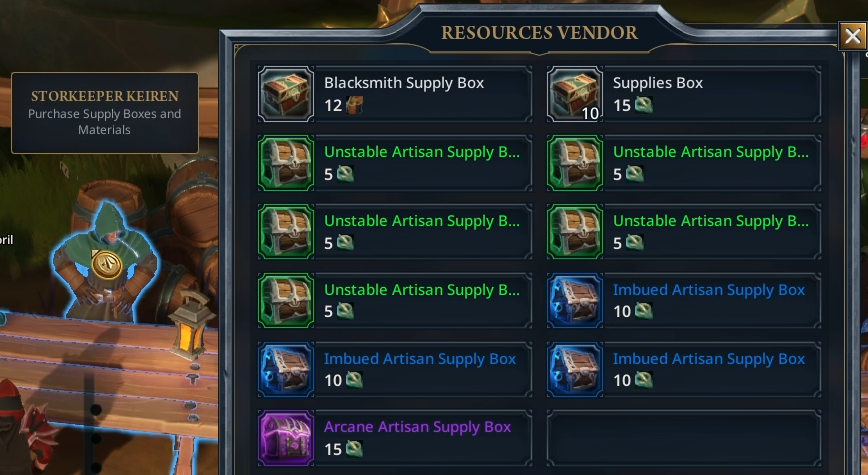
The Storekeeper sells resources for Supplies and Marks. Each of the supply boxes have different items and different cooldowns.
| Box | Cooldown | Rewards |
|---|---|---|
| Blacksmith Supply Box | 1 Hour | 60x Gold, 3x Materia, 1x Magic Essence |
| Supplies Box | Instant | 10x Supplies |
| Unstable Artisan Supply Box | Daily Reset | 1x Unstable Mithril, 1x Unstable Aether, 1x Defender’s Godstone |
| Imbued Artisan Supply Box | Weekly Reset | 1x Imbued Mithril, 1x Inbued Aether, 1x Hero’s Godstone |
| Arcane Artisan Supply Box | Weekly Reset | 1x Arcane Mithril, 1x Arcane Aether, 1x Legend’s Godstone |
Early game, unless you’re conserving resources to buy a mount or other cosmetic items, Blacksmith supply boxes should be purchased as regularly as possible as gold will push your item-level and allow you to progress faster and more comfortably.
Combat Controls and Quality of Life
Alerts and Customizable UI
Fellowship has built-in alerts for boss mechanics, DPS / HPS meters, and fully custom UI. In the Edit UI screen you can change the size and position of various elements such as meters, timers, and your hotbars.
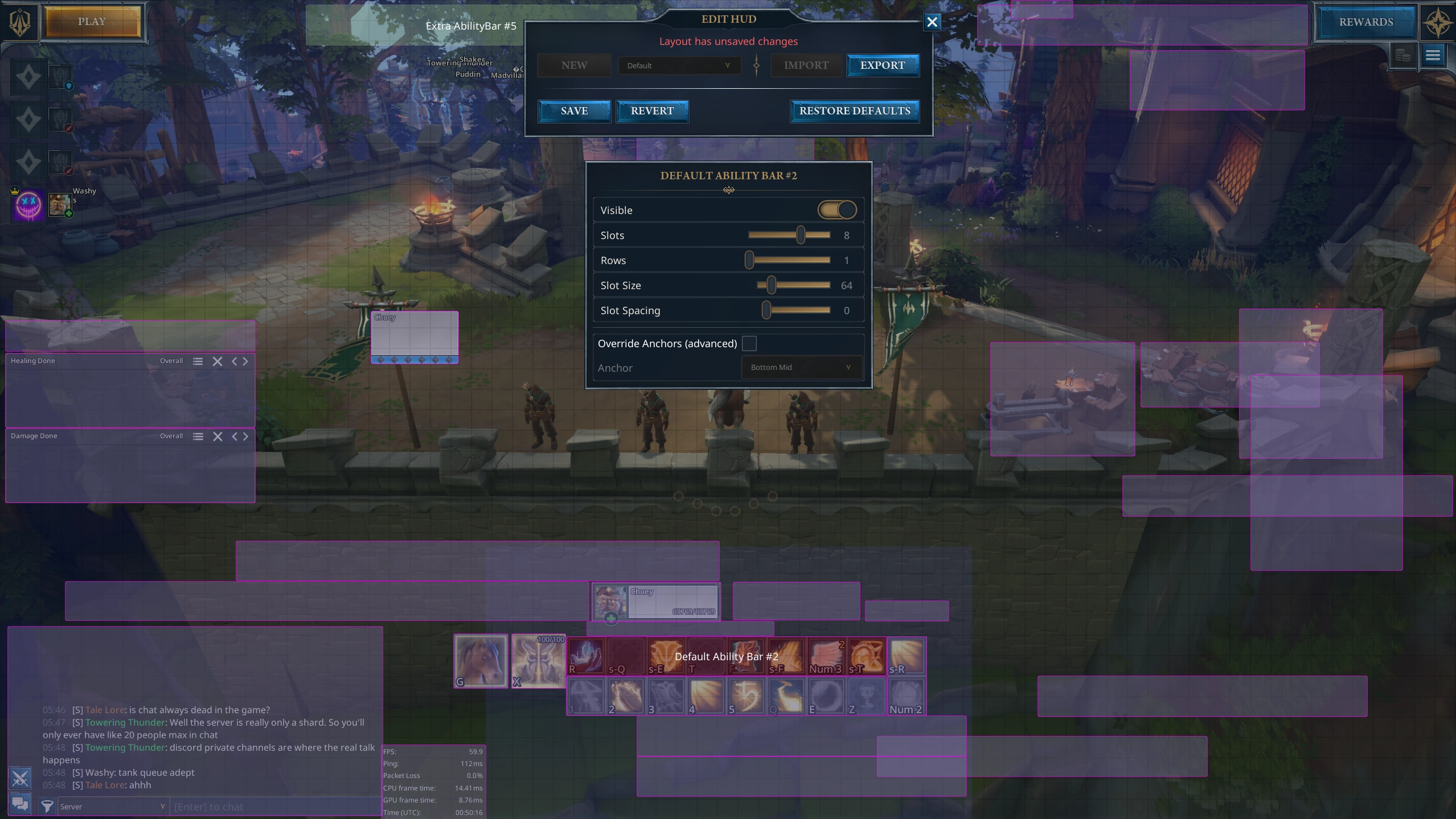
You can export and import UIs from the Edit UI screen, and find shared UIs online such as here.
Rebinding Abilities
To rebind your abilities, right-click on the respective ability on the bar and Set Keybind from there. Fellowship accepts CTRL, ALT and SHIFT modifiers as well as additional mouse buttons. These keys are saved per UI slot.
Interrupting Casts and Crowd Control
Even with careful mitigation usage, enemy spells can be devastating to the party. Spellcasters will often attack with filler spells that do damage to the tank (or a random target), and sometimes more dangerous spells. These spells are indicated by a yellow cast bar.
ALL TANK AND DPS HEROES have an Interrupt ability that can stop these spells (often dubbed as ‘kicking’). When starting out, you should prioritize the most dangerous ones, but as you get to higher difficulties, even the filler spells start to hurt a lot more, so you will need to coordinate with your party. After you interrupt the enemy, they will not be able to cast for 4 seconds (except dedicated boss timers).
In Fellowship, you can target an enemy with an interrupt marker and a cooldown. By default, this is V. This will show your allies who you are targeting with your kick, and whether or not it’s ready.
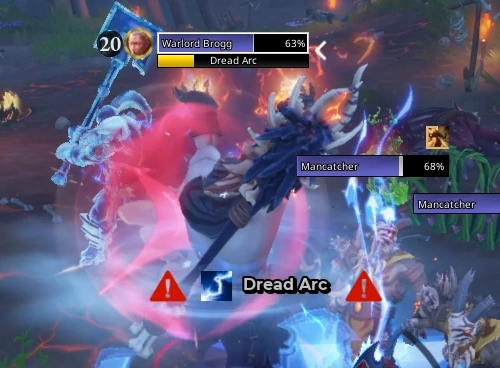
Another way to interrupt casts is through Crowd Control (CC). In a pinch, any type of stun or forced movement will interrupt an enemy’s cast, such as Cyclone or Charge.
Lastly, some enemies have some abilities indicated by a grey cast-bar. You can’t interrupt these abilities, but you CAN CC them. Sometimes these abilities can be powerful, so it’s worth doing if you have the opportunity.
Fellowship Beginner Tips
Getting started in Fellowship is pretty straightforward, but there are a few things that will make your first hours feel even better – and help you avoid some common pitfalls.
Heroes and Builds
- Don’t stress too much over your first hero pick. The game is designed for experimenting and trying new heroes out easily.
- Use Quickplay to practice unfamiliar heroes and roles.
- Experiment with talents and what feels right. Respeccing is instant and free.
- If you pick up a legendary, try building talents around it for better results.
- Don’t be shy to pickup defensive talents at later difficulties, enemies can seriously hurt late game.
Progression
- Use Marks of Fellowship to fill your empty gear slots early on. This makes a massive difference to your overall strength.
- Speedrunning Quickplay is a great way to push your left-side reward track or gear secondary heroes through the Equipment Vendor.
- Don’t be shy to use your gold to upgrade your gear. You get half of it back when scrapping the item if you get an upgrade down the line.
- Don’t be shy to use the Unstable Ingots to reroll items you are going to scrap. At 20 gold per, it’s worth trying to swap it for a potential upgrade.
- Save your expensive rerolls for Epic or higher, as you will want to chase a weapon or other upgrades.
Dungeon & Run Strategy
- Interrupt. DPS need to interrupt just as much as tanks.
- Quickplay can be speedran very, very quickly with much larger pulls than you could do in normal Challenger dungeons.
- Early difficulties are where you can experiment with routes and should still be able to effectively time dungeons.
- Dungeons still give loot during over-time. If the dungeon is clear-able, it’s always better to stay and finish it.
